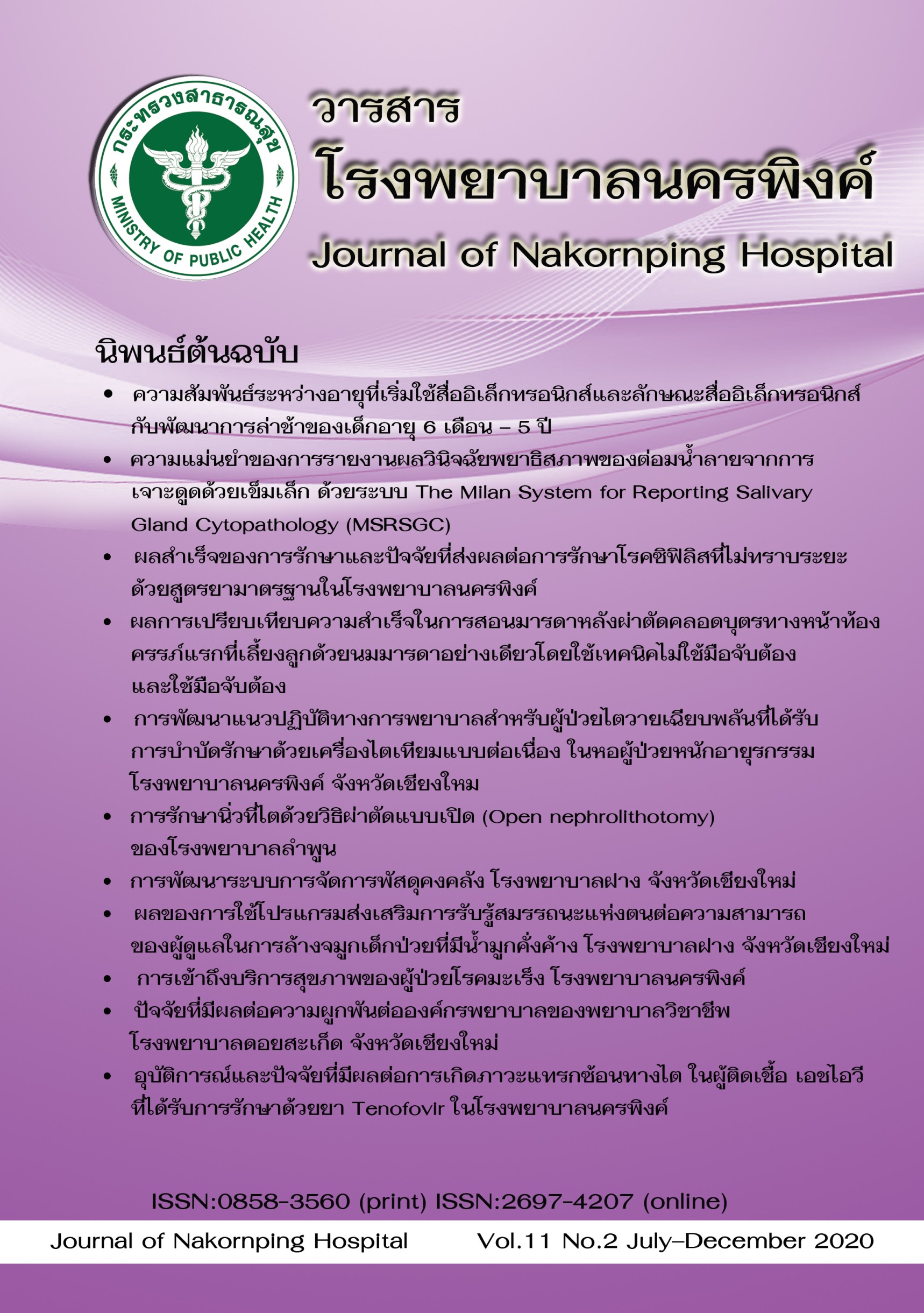Open Nephrolithotomy in Lamphun hospital
Keywords:
open nephrolithotomy, stone free rate, high serum creatinine, staghorn calculiAbstract
This study objective is to evaluate the outcome of open nephrolithotomy, stone free rate, complications and factors associated with stone free patient treated by open nephrolithotomy.
Method: The retrospective analytic research was conducted in renal calculi patients who had open nephrolithotomy during 2011-2019 in Lamphun hospital. Data were retrieved from medical records and operative notes in all open nephrolithotomy patients. Data were analysed by descriptive and inferential statistical analysis presented as mean, standard deviation, median, iqr, min, max, Odds ratio and 95% confidence interval.
Result: Total 105 open nephrolithotomy patients were included into the study. The mean age was 54.04 years (SD 9.67), 93 (88.57%) had diagnosed with partial or complete staghorn calculi, median Guy’s stone score and calculus size were 4 (iqr 1) and 6.5 cm. (iqr2.5), 39 cases (37.14%) had serum creatinine ≥ 1.5 mg/dL and 66 cases (62.86%) had serum creatinine less than 1.5 mg/dL, mean intraoperative ischemia time was 43.50 minutes (SD 13.14), median operative time and blood loss were 78 minutes (iqr 35) and 150 cc (iqr 100) respectively. Postoperative complications were recorded in 13 cases (12.28%) and 2 cases needed to reoperation. Stone free rate was 39.05% (41 cases). Factor associated with stone free was serum creatinine ≥ 1.5 mg/dL, Adj. Odds ratio 1.37 (95% CI 1.07 - 1.75).
Conclusion: Open nephrolithotomy had good stone free rate even though the operation had some complications. This technique can be used with more confidence in stone free rate in patient who had high serum creatinine.
References
Lamphun hospital. Annual patient record. Lamphun: Lamphun hospital; 2019.
Saiwongse N. Anatrophic nephrolithomy for kidney stones surgery Nongbualumphu Hospital 1996-1998. Journal of Health Science. 1999;8(1):126-132. (In Thai)
Srisuphanthong S. New trend in management of ureteric orifice stone. Lampang Medical Journal. 1998;19(1):16-21. (In Thai)
Kijvikai K, Leenanupunth C, Sirisriro R, Lertsithichai P. Comparative Study of Renal Function between Standard and Modified Anatrophic Nephrolithotomy by Radionuclide Renal Scans. J Med Assoc Thai. 2004;87(6):704. (In Thai)
Sawangsupakun W. Percutaneous nephrolithotomy versus open surgery for renal calculi. Journal of Health Science. 2009;18(3):388-396. (In Thai)
Trisakul Y. Modified anatrophic nephrolithotomy in Yasothon Hospital. Medical journal of Ubon Hospital. 2002;23(1):13-18. (In Thai)
Moreno-Palacios J, Avilés-Ibarra OJ, García-Peña E, Torres-Anguiano JR, Serrano-Brambilia EA, López-Sámano VA, et al. Rearrangement of the Guy's stone score improves prediction of stone-free rate after percutaneous nephrolithotomy. Turk J Urol. 2018;44(1):36-41.
Wattanachot D. Calculi, methods of treatment and prevention. Morchoban. 1988;10:22-30. (In Thai)
Alaoui AE, Boté HE, Ziouani O, Sayegh HE, Iken A, Benslimane L, et al. Place de la néphrolithotomie à ciel ouvert dans le traitement du calcul coralliforme: à propos d'une série de 53 patients [The role of open nephrolithotomy in the treatment of coralliform stones: a series of 53 patients]. Pan Afr Med J. 2019;32:110.
Likitwattanasakul J. Comparison of Percutaneous Nephrolithotomy and Anatrophic Nephrolithotomy. Journal of Health Science. 2010:19(6):954-60. (In Thai)
Trisakul Y. Five year ureterorenoscopy experiences in Yasothon Hospital. Yasothon medical journal. 1999;1(2):132-138. (In Thai)
Partin AW, Wein AJ, Kavoussi LR, Peters CA, Dmochowski RR. Campbell walsh wein urology. 12th ed. US: Elsevier; 2020.
Downloads
Published
How to Cite
Issue
Section
License
The articles that had been published in the journal is copyright of Journal of Nakornping hospital, Chiang Mai.
Contents and comments in the articles in Journal of Nakornping hospital are at owner’s responsibilities that editor team may not totally agree with.



